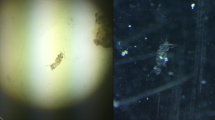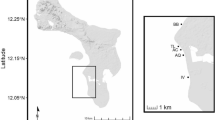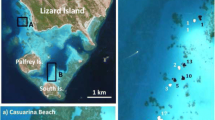Abstract
Cleaning behavior is a well-known example of trophic specialization that is widespread in marine organisms from both tropical and temperate ecosystems. Cleaner species can be more or less specialized in different aspects of cleaning interactions, and it is often assumed that the more specialized cleaners are, the more they rely on clients for food. However, cleaners can consume different items in different sites, and the factors influencing such variation are still poorly understood. Here, we investigated the diet and distribution of the barber goby Elacatinus figaro across marginal reefs of the Brazilian coast. We evaluated E. figaro’s reliance on cleaning interactions for food and asked whether its diet and abundance corresponded to the availability of ectoparasites and/or clients. The diet of E. figaro varied across sites, but ectoparasite reliance was similar and did not correspond to client’s infestation loads. Moreover, the density of E. figaro did not correlate with the density or richness of potential clients. These support the hypothesis that E. figaro is less reliant on cleaning interactions for food than other cleaning goby species and suggest a high feeding and behavioral plasticity in marginal reefs. This study also highlights that the current dichotomous classification scheme of dedicated versus facultative cleaners fails to capture the subtle nuances of cleaning behavior and should therefore be used with caution in future comparative studies.






Similar content being viewed by others
Code availability
The R scripts used to analyze data and produce figures are available from the corresponding author on request.
References
Arnal C (2000) Diet of broadstripe cleaning gobies on a Barbadian reef. J Fish Biol 57:1075–1082. https://doi.org/10.1006/jfbi.2000.1371
Arnal C, Morand S (2001) Importance of ectoparasites and mucus in cleaning interactions in the Mediterranean cleaner wrasse Symphodus melanocercus. Mar Biol 138:777–784. https://doi.org/10.1007/s002270000494
Arnal C, Morand S, Kulbicki M (1999) Patterns of cleaner wrasse density among three regions of the Pacific. Mar Ecol Prog Ser 177:213–220. https://doi.org/10.3354/meps177213
Arnal C, Côté IM, Sasal P, Morand S (2000) Cleaner–client interactions on a Caribbean reef: influence of correlates of parasitism. Behav Ecol Sociobiol 47:353–358. https://doi.org/10.1007/s002650050676
Arnal C, Côté IM, Morand S (2001) Why clean and be cleaned? The importance of client ectoparasites and mucus in a marine cleaning symbiosis. Behav Ecol Sociobiol 51:1–7. https://doi.org/10.1007/s002650100407
Arnal C, Kulbicki M, Harmelin-Vivien M, Galzin R, Morand S (2002) Patterns of local distribution of Labroides dimidiatus in French Polynesian atolls. Environ Biol Fish 63:9–15. https://doi.org/10.1023/A:1013811205742
Aued AW, Smith F, Quimbayo JP, Cândido DV, Longo GO, Ferreira CEL, Witman JD, Floeter SR, Segal B (2018) Large-scale patterns of benthic marine communities in the Brazilian Province. PLoS ONE 13:e0198452. https://doi.org/10.1371/journal.pone.0198452
Baker R, Buckland A, Sheaves M (2014) Fish gut content analysis: robust measures of diet composition. Fish Fish 15:170–177. https://doi.org/10.1111/faf.12026
Baliga VB, Law CJ (2016) Cleaners among wrasses: phylogenetics and evolutionary patterns of cleaning behavior within Labridae. Mol Phylogenet Evol 94:424–435
Baliga VB, Mehta RS (2019) Morphology, ecology, and biogeography of independent origins of cleaning behavior around the world. Integr Comp Biol 59:625–637. https://doi.org/10.1093/icb/icz030
Bansemer C, Grutter AS, Poulin R (2002) Geographic variation in the behaviour of the cleaner fish Labroides dimidiatus (Labridae). Ethology 108:353–366. https://doi.org/10.1046/j.1439-0310.2002.00777.x
Bush AO, Lafferty KD, Lotz JM, Shostak AW (1997) Parasitology meets ecology on its own terms: Margolis et al. revisited. J Parasitol 83:575. https://doi.org/10.2307/3284227
Campos CEC, Sá-Oliveira JC (2011) Atividade de limpeza e clientes de Elacatinus figaro (Pisces: Gobiidae) nos recifes de coral dos Parrachos de Muriú, Nordeste do Brasil. Biota Neotrop 11:47–51. https://doi.org/10.1590/S1676-06032011000100004
Castelnau FL (1855) Poissons. Animaux nouveaux or rares recueillis pendant l’expédition dans les parties centrales de l’Amérique du Sud, de Rio de Janeiro a Lima, et de Lima au Para; exécutée par ordre du gouvernement Français pendant les années 1843 a 1847. Bertrand, Paris, pp xii–112
Castro CB, Segal B, Negrão F, Calderon EN (2012) Four-year monthly sediment deposition on turbid southwestern Atlantic coral reefs, with a comparison of benthic assemblages. Braz. J. Oceanogr. 60(1):49–63. https://doi.org/10.1590/S1679-87592012000100006
Cheney KL, Côté IM (2001) Are Caribbean cleaning symbioses mutualistic? Costs and benefits of visiting cleaning stations to longfin damselfish. Anim Behav 62:927–933. https://doi.org/10.1006/anbe.2001.1832
Cheney K, Côté I (2003) Do ectoparasites determine cleaner fish abundance? Evidence on two spatial scales. Mar Ecol Prog Ser 263:189–196. https://doi.org/10.3354/meps263189
Cheney KL, Côté IM (2005) Mutualism or parasitism? The variable outcome of cleaning symbioses. Biol Lett 1:162–165. https://doi.org/10.1098/rsbl.2004.0288
Coelho-Souza SA, López MS, Guimarães JRD, Coutinho R, Candella RN (2012) Biophysical interactions in the Cabo Frio upwelling system, Southeastern Brazil. Braz J Oceanogr 60:353–365. https://doi.org/10.1590/s1679-87592012000300008
Côté IM (2000) Evolution and ecology of cleaning symbioses in the sea. Oceanogr Mar Biol 38:311–355
Côté I, Soares M (2011) Gobies as cleaners. In: Kapoor B (ed) The biology of gobies. Science Publishers, pp 532–557
Cote IM, Molloy PP (2003) Temporal variation in cleanerfish and client behaviour: does it reflect ectoparasite availability? Ethology 109:487–499. https://doi.org/10.1046/j.1439-0310.2003.00883.x
Cuvier G, Valenciennes A (1830) Histoire naturelle des poissons. Tome cinquième. Chez F.G, Levrault, Paris
Dunkley K, Ioannou CC, Whittey KE, Cable J, Perkins SE (2019a) Cleaner personality and client identity have joint consequences on cleaning interaction dynamics. Behav Ecol 30:703–712. https://doi.org/10.1093/beheco/arz007
Dunkley K, Ellison AR, Mohammed RS, van Oosterhout C, Whittey KE, Perkins SE, Cable J (2019b) Long-term cleaning patterns of the sharknose goby (Elacatinus evelynae). Coral Reefs 38:321–330. https://doi.org/10.1007/s00338-019-01778-9
Dunkley K, Ward AJW, Perkins SE, Cable J (2020) To clean or not to clean: cleaning mutualism breakdown in a tidal environment. Ecol Evol 10:3043–3054. https://doi.org/10.1002/ece3.6120
Ekau W, Knoppers B (1999) An introduction to the pelagic system of the Northeast and East Brazilian shelf. Arch Fish Mar Res 47:113–132
Ferreira CEL, Floeter SR, Gasparini JL, Ferreira BP, Joyeux JC (2004) Trophic structure patterns of Brazilian reef fishes: a latitudinal comparison. J Biogeogr 31:1093–1106. https://doi.org/10.1111/j.1365-2699.2004.01044.x
Floeter SR, Guimarães RZP, Rocha LA, Ferreira CEL, Rangel CA, Gasparine JL (2001) Geographic variation in reef-fish assemblages along the Brazilian coast. Glob Ecol Biogeogr 10:423–431
Floeter SR, Krohling W, Gasparini JL, Ferreira CEL, Zalmon IR (2007) Reef fish community structure on coastal islands of the southeastern Brazil: the influence of exposure and benthic cover. Environ Biol Fish 78:147–160. https://doi.org/10.1007/s10641-006-9084-6
Fox J, Weisberg S (2019) An R companion to applied regression, 3rd edn. Sage, Thousand Oaks CA
Francini-Filho RB, Sazima I (2008) A comparative study of cleaning activity of two reef fishes at Fernando de Noronha Archipelago, tropical West Atlantic. Environ Biol Fish 83:213–220. https://doi.org/10.1007/s10641-007-9322-6
Froese R (2006) Cube law, condition factor and weight–length relationships: history, meta-analysis and recommendations. J Appl Ichthyol 22:241–253. https://doi.org/10.1111/j.1439-0426.2006.00805.x
Fulton CJ, Wainwright PC, Hoey AS, Bellwood DR (2017) Global ecological success of Thalassoma fishes in extreme coral reef habitats. Ecol Evol 7:466–472. https://doi.org/10.1002/ece3.2624
Grutter AS (1997) Spatiotemporal variation and feeding selectivity in the diet of the cleaner fish Labroides dimidiatus. Copeia 1997:346. https://doi.org/10.2307/1447754
Grutter AS (1999) Fish cleaning behaviour in Noumea. New Caledonia Mar Freshw Res 50:209. https://doi.org/10.1071/MF97078
Grutter AS (2000) Ontogenetic variation in the diet of the cleaner fish Labroides dimidiatus and its ecological consequences. Mar Ecol Prog Ser 197:241–246
Hervé M (2017) RVAideMemoire: testing and plotting procedures for biostatistics. R package version 0.9–68. https://cran.r-project.org/package=RVAideMemoire
Huie JM, Thacker CE, Tornabene L (2020) Co-evolution of cleaning and feeding morphology in western Atlantic and eastern Pacific gobies. Evolution 74:419–433. https://doi.org/10.1111/evo.13904
Johnson WS, Ruben P (1988) Cleaning behavior of Bodianus rufus, Thalassoma bifasciatum, Gobiosoma evelynae, and Periclimenes pedersoni along a depth gradient at salt river submarine Canyon. St Croix Environ Biol Fish 23:225–232. https://doi.org/10.1007/BF00004913
Kleypas JA, Mcmanus JW, Meñez LAB (1999) Environmental limits to coral reef development: where do we draw the line? Am Zool 39:146–159. https://doi.org/10.1093/icb/39.1.146
Leão ZMAN, Dominguez JML (2000) Tropical coast of Brazil. Mar Pollut Bull 41:112–122. https://doi.org/10.1016/S0025-326X(00)00105-3
Lenth RV (2016) Least-squares means: the r package lsmeans. J Stat Softw. https://doi.org/10.18637/jss.v069.i01
Liedke AMR, Barneche DR, Ferreira CEL, Segal B, Nunes LT, Burigo AP, Carvalho JA, Buck S, Bonaldo RM, Floeter SR (2016) Abundance, diet, foraging and nutritional condition of the banded butterflyfish (Chaetodon striatus) along the western Atlantic. Mar Biol 163:1–13. https://doi.org/10.1007/s00227-015-2788-4
Maida M, Ferreira BP (1997) Coral reefs of Brazil overview and field guide. In: Proceedings 8th International Coral Reef Symposium 1:263–274
Morado N, Mota PG, Soares MC (2019) The rock cook wrasse Centrolabrus exoletus aims to clean. Front Ecol Evol. https://doi.org/10.3389/fevo.2019.00182
Morais RA, Ferreira CEL, Floeter SR (2017) Spatial patterns of fish standing biomass across Brazilian reefs. J Fish Biol 91(6):1642–1667. https://doi.org/10.1111/jfb.13482
Narvaez P, Furtado M, Neto A, Moniz I, Azevedo J, Soares M (2015) Temperate facultative cleaner wrasses selectively remove ectoparasites from their client-fish in the Azores. Mar Ecol Prog Ser 540:217–226. https://doi.org/10.3354/meps11522
Oates J, Manica A, Bshary R, Grutter AS (2012) Relationship between roving behaviour and the diet and client composition of the cleaner fish Labroides bicolor. J Fish Biol 81:210–219
Oksanen J, Blanchet FG, Kindt R, Legendre P, Minchin PR, O’hara RB, Simpson GL, Solymos P, Stevens MHH, Wagner H, Oksanen MJ (2013) Package ‘vegan’. Community ecology package, version, 2(9). https://cran.r-project.org/web/packages/vegan/index.html
de Palmeira ACPA, de Camargo R, de Palmeira RMJ, de Palmeira ACPA, de Camargo R, de Palmeira RMJ (2015) Relação entre a temperatura da superfície do mar e a camada de mistura oceânica sob a passagem de ciclones extratropicais no Atlântico Sudoeste. Rev Bras Meteorol 30:89–100. https://doi.org/10.1590/0102-778620130679
Perry CT, Larcombe P (2003) Marginal and non-reef-building coral environments. Coral Reefs 22:427–432. https://doi.org/10.1007/s00338-003-0330-5
Quimbayo JP, Zapata FA (2018) Cleaning interactions by gobies on a tropical eastern Pacific coral reef. J Fish Biol 92:1110–1125. https://doi.org/10.1111/jfb.13573
Quimbayo JP, Nunes LT, Ozekoski R, Floeter SR, Morais RA, Fontoura L, Bonaldo RM, Ferreira CEL, Sazima I (2017) Cleaning interactions at the only atoll in the South Atlantic. Environ Biol Fish 100:865–875. https://doi.org/10.1007/s10641-017-0612-3
Quimbayo JP, Schlickmann ORC, Floeter SR, Sazima I (2018) Cleaning interactions at the southern limit of tropical reef fishes in the Western Atlantic. Environ Biol Fish 101:1195–1204. https://doi.org/10.1007/s10641-018-0768-5
R Core Team (2020) R: a language and environment for statistical computing. https://www.R-project.org/.
Rocha LA, Rosa IL, Feitoza B (2000) Sponge-dwelling fishes of Northeastern Brazil. Environ Biol Fish 59:453–458. https://doi.org/10.1023/A:1026584708092
Sazima I, Moura RL, Rosa RS (1997) Elacatinus figaro sp.n (Perciformes: Gobiidae), a new cleaner goby from the coast of Brazil. Aqua J Ichthyol Aquat Biol 2:33–38
Sazima I, Moura RL, Sazima C (1999) Cleaning activity of juvenile angelfish, Pomacanthus paru, on the reefs of the Abrolhos Archipelago, Western South Atlantic. Environ Biol Fish 56:399–407. https://doi.org/10.1023/A:1007531925845
Sazima I, Sazima C, Francini-Filho RB, Moura RL (2000) Daily cleaning activity and diversity of clients of the barber goby, Elacatinus figaro, on rocky reefs in southeastern Brazil. Environ Biol Fish 59:69–77
Sikkel P, Fuller C, Hunte W (2000) Habitat/sex differences in time at cleaning stations and ectoparasite loads in a Caribbean reef fish. Mar Ecol Prog Ser 193:191–199. https://doi.org/10.3354/meps193191
Sikkel PC, Cheney KL, Côté IM (2004) In situ evidence for ectoparasites as a proximate cause of cleaning interactions in reef fish. Anim Behav 68:241–247. https://doi.org/10.1016/j.anbehav.2003.10.023
Soares MC, Cardoso SC, Côté IM (2007) Client preferences by Caribbean cleaning gobies: food, safety or something else? Behav Ecol Sociobiol 61:1015–1022. https://doi.org/10.1007/s00265-006-0334-6
Soares MC, Côté IM, Cardoso SC, Bshary R (2008) The cleaning goby mutualism: a system without punishment, partner switching or tactile stimulation. J Zool 276:306–312. https://doi.org/10.1111/j.1469-7998.2008.00489.x
Spalding M, Spalding MD, Ravilious C, Green EP (2001) World atlas of coral reefs. Univ of California Press
Steindachner F (1878) Ichthyologische beiträge. VI Sitzungsber Akad Wiss Wien 77:379–392
Vaughan DB, Grutter AS, Costello MJ, Hutson KS (2016) Cleaner fishes and shrimp diversity and a re-evaluation of cleaning symbioses. Fish Fish 18:698–716. https://doi.org/10.1111/faf.12198
White JW, Grigsby CJ, Warner RR (2007) Cleaning behavior is riskier and less profitable than an alternative strategy for a facultative cleaner fish. Coral Reefs 26:87–94. https://doi.org/10.1007/s00338-006-0161-2
Whiteman EA, Côté IM (2002) Cleaning activity of two Caribbean cleaning gobies: intra- and interspecific comparisons. J Fish Biol 60:1443–1458. https://doi.org/10.1006/jfbi.2002.1947
Whiteman EA, Côté IM (2004) Dominance hierarchies in group-living cleaning gobies: causes and foraging consequences. Anim Behav 67:239–247. https://doi.org/10.1016/j.anbehav.2003.04.006
Willis TJ (2001) Visual census methods underestimate density and diversity of cryptic reef fishes. J Fish Biol 59:1408–1411. https://doi.org/10.1111/j.1095-8649.2001.tb00202.x
Xavier R, Mazzei R, Pérez-Losada M, Rosado D, Santos JL, Veríssimo A, Soares MC (2019) A risky business? Habitat and social behavior impact skin and gut microbiomes in Caribbean cleaning gobies. Front Microbiol 10:716. https://doi.org/10.3389/fmicb.2019.00716
Acknowledgments
We would like to thank Guilherme O. Longo and the SISBIOTA network for the assistance in the field, Virginia Paola for the ectoparasites identification, and two anonymous reviewers for their helpful comments and suggestions. RM was supported by a Master’s scholarship from Conselho Nacional de Desenvolvimento Científico e Tecnológico (CNPq). TCM was supported by Fundação de Amparo à Pesquisa do Estado do Rio de Janeiro (FAPERJ) with a Nota 10 fellowship (# E-26/202.858/2016). JLL was supported by a research fellowship from CNPq. CELF is supported by CNPq and FAPERJ grants. CAMMC was supported by Coordenação de Aperfeiçoamento de Pessoal de Nível Superior (CAPES). M.C.S. is currently supported by National Funds through Fundação para a Ciência e a Tecnologia (DL57/2016/CP1440/CT0019).
Funding
This study was funded by the Conselho Nacional de Desenvolvimento Científico e Tecnológico (CNPq) and the Fundação de Amparo à Pesquisa do Estado do Rio de Janeiro (FAPERJ) through research funds granted to CELF.
Author information
Authors and Affiliations
Contributions
RM, MCS, and CELF designed the study. RM, TCM, and CAMMC collected and analyzed the data. JLL identified the ectoparasites. RM wrote the manuscript. All authors discussed the results and commented on the manuscript.
Corresponding author
Ethics declarations
Conflict of interest
The authors have no conflict of interest to declare.
Ethics approval
Research methods and capture of specimens at protected sites within the study areas were under authorization of the Brazilian environmental agency ICMBIO/SISBIO (Permit numbers: 33688-1 and 32652-1).
Additional information
Responsible Editor: D. Goulet.
Publisher's Note
Springer Nature remains neutral with regard to jurisdictional claims in published maps and institutional affiliations.
Reviewers: V. Baliga and an undisclosed expert.
Supplementary Information
Below is the link to the electronic supplementary material.
Rights and permissions
About this article
Cite this article
Mazzei, R., Mendes, T.C., Cordeiro, C.A.M.M. et al. Diet and abundance of the barber goby Elacatinus figaro on Brazilian marginal reefs: ecological predictors and reliance on cleaning interactions. Mar Biol 168, 64 (2021). https://doi.org/10.1007/s00227-021-03856-5
Received:
Accepted:
Published:
DOI: https://doi.org/10.1007/s00227-021-03856-5




